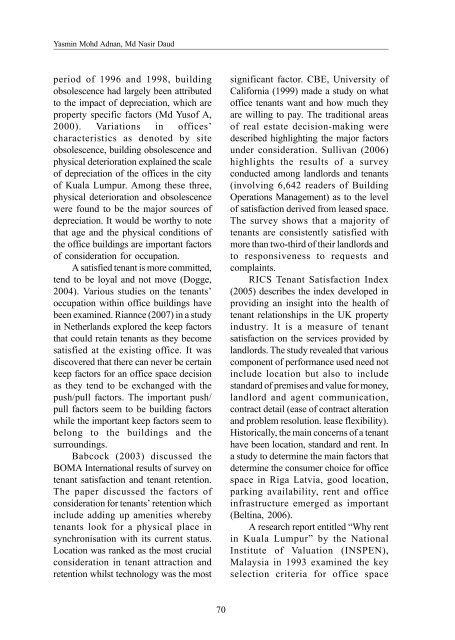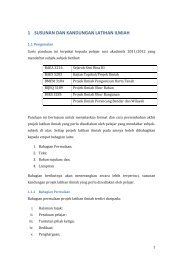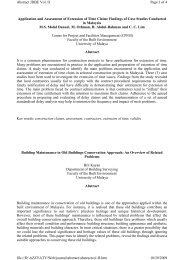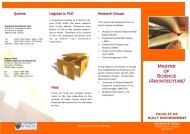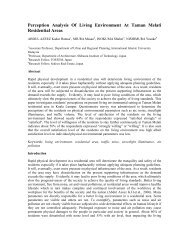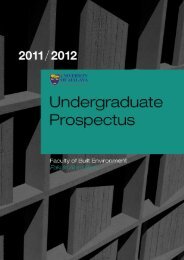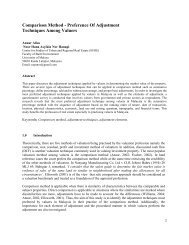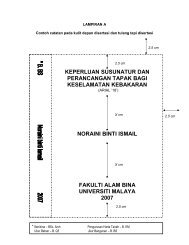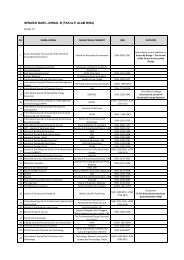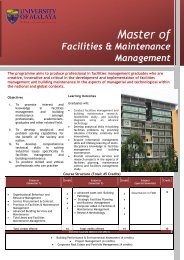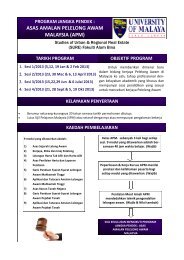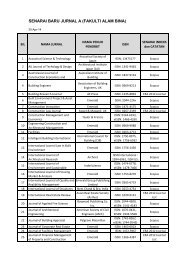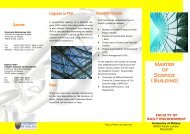Factors Influencing Office Building Occupation Decision by Tenants ...
Factors Influencing Office Building Occupation Decision by Tenants ...
Factors Influencing Office Building Occupation Decision by Tenants ...
You also want an ePaper? Increase the reach of your titles
YUMPU automatically turns print PDFs into web optimized ePapers that Google loves.
Yasmin Mohd Adnan, Md Nasir Daudperiod of 1996 and 1998, buildingobsolescence had largely been attributedto the impact of depreciation, which areproperty specific factors (Md Yusof A,2000). Variations in offices’characteristics as denoted <strong>by</strong> siteobsolescence, building obsolescence andphysical deterioration explained the scaleof depreciation of the offices in the cityof Kuala Lumpur. Among these three,physical deterioration and obsolescencewere found to be the major sources ofdepreciation. It would be worthy to notethat age and the physical conditions ofthe office buildings are important factorsof consideration for occupation.A satisfied tenant is more committed,tend to be loyal and not move (Dogge,2004). Various studies on the tenants’occupation within office buildings havebeen examined. Riannce (2007) in a studyin Netherlands explored the keep factorsthat could retain tenants as they becomesatisfied at the existing office. It wasdiscovered that there can never be certainkeep factors for an office space decisionas they tend to be exchanged with thepush/pull factors. The important push/pull factors seem to be building factorswhile the important keep factors seem tobelong to the buildings and thesurroundings.Babcock (2003) discussed theBOMA International results of survey ontenant satisfaction and tenant retention.The paper discussed the factors ofconsideration for tenants’ retention whichinclude adding up amenities where<strong>by</strong>tenants look for a physical place insynchronisation with its current status.Location was ranked as the most crucialconsideration in tenant attraction andretention whilst technology was the mostsignificant factor. CBE, University ofCalifornia (1999) made a study on whatoffice tenants want and how much theyare willing to pay. The traditional areasof real estate decision-making weredescribed highlighting the major factorsunder consideration. Sullivan (2006)highlights the results of a surveyconducted among landlords and tenants(involving 6,642 readers of <strong>Building</strong>Operations Management) as to the levelof satisfaction derived from leased space.The survey shows that a majority oftenants are consistently satisfied withmore than two-third of their landlords andto responsiveness to requests andcomplaints.RICS Tenant Satisfaction Index(2005) describes the index developed inproviding an insight into the health oftenant relationships in the UK propertyindustry. It is a measure of tenantsatisfaction on the services provided <strong>by</strong>landlords. The study revealed that variouscomponent of performance used need notinclude location but also to includestandard of premises and value for money,landlord and agent communication,contract detail (ease of contract alterationand problem resolution. lease flexibility).Historically, the main concerns of a tenanthave been location, standard and rent. Ina study to determine the main factors thatdetermine the consumer choice for officespace in Riga Latvia, good location,parking availability, rent and officeinfrastructure emerged as important(Beltina, 2006).A research report entitled “Why rentin Kuala Lumpur” <strong>by</strong> the NationalInstitute of Valuation (INSPEN),Malaysia in 1993 examined the keyselection criteria for office space70


